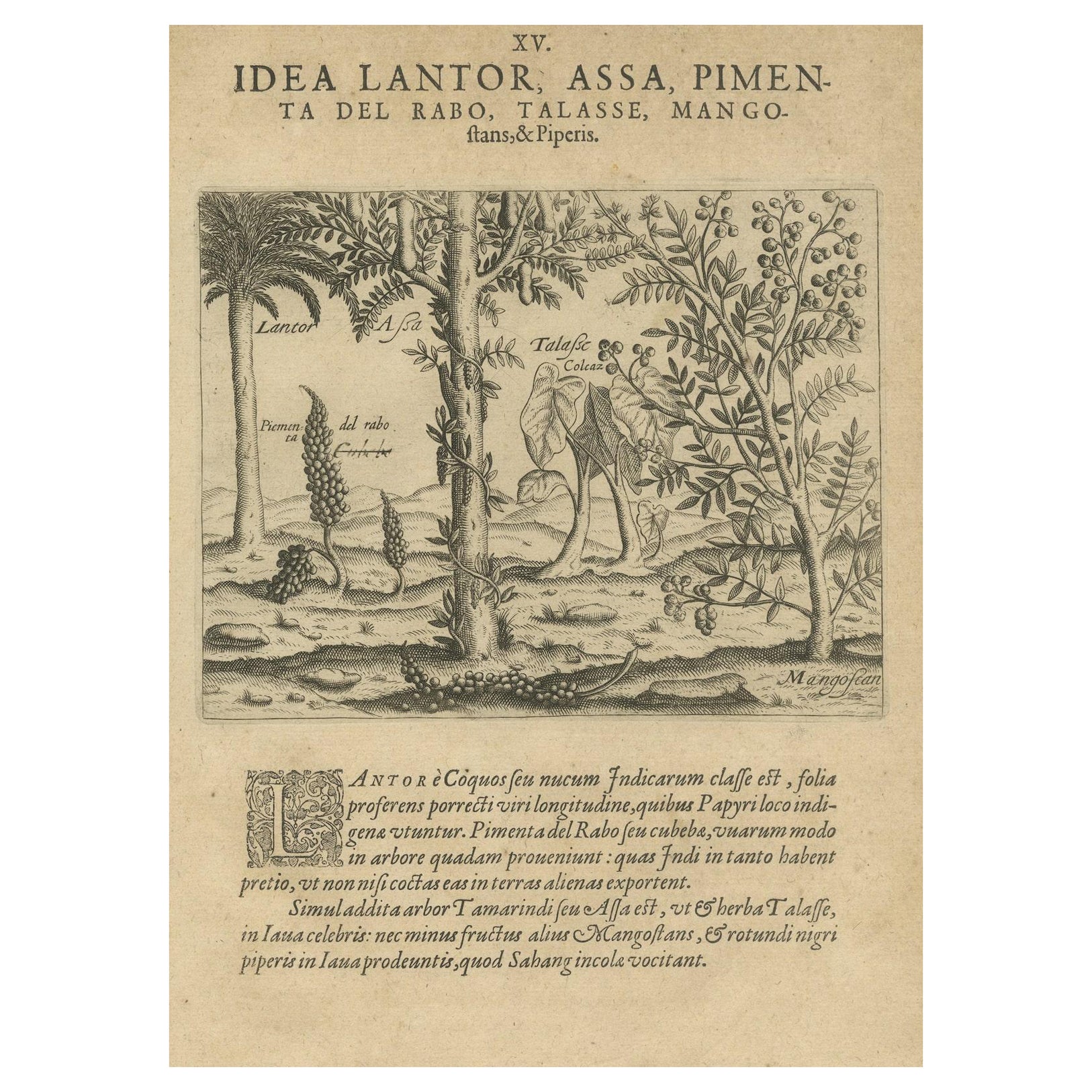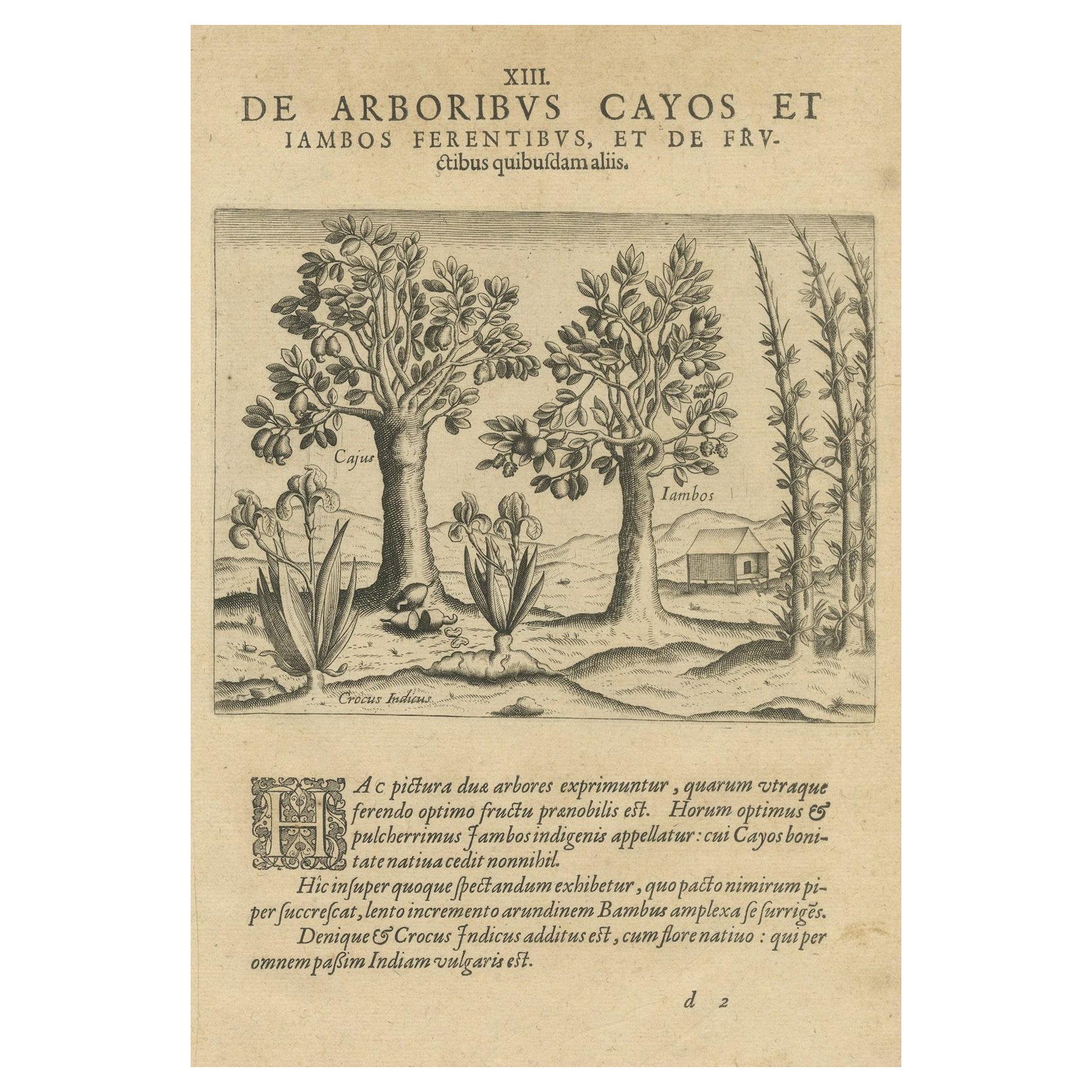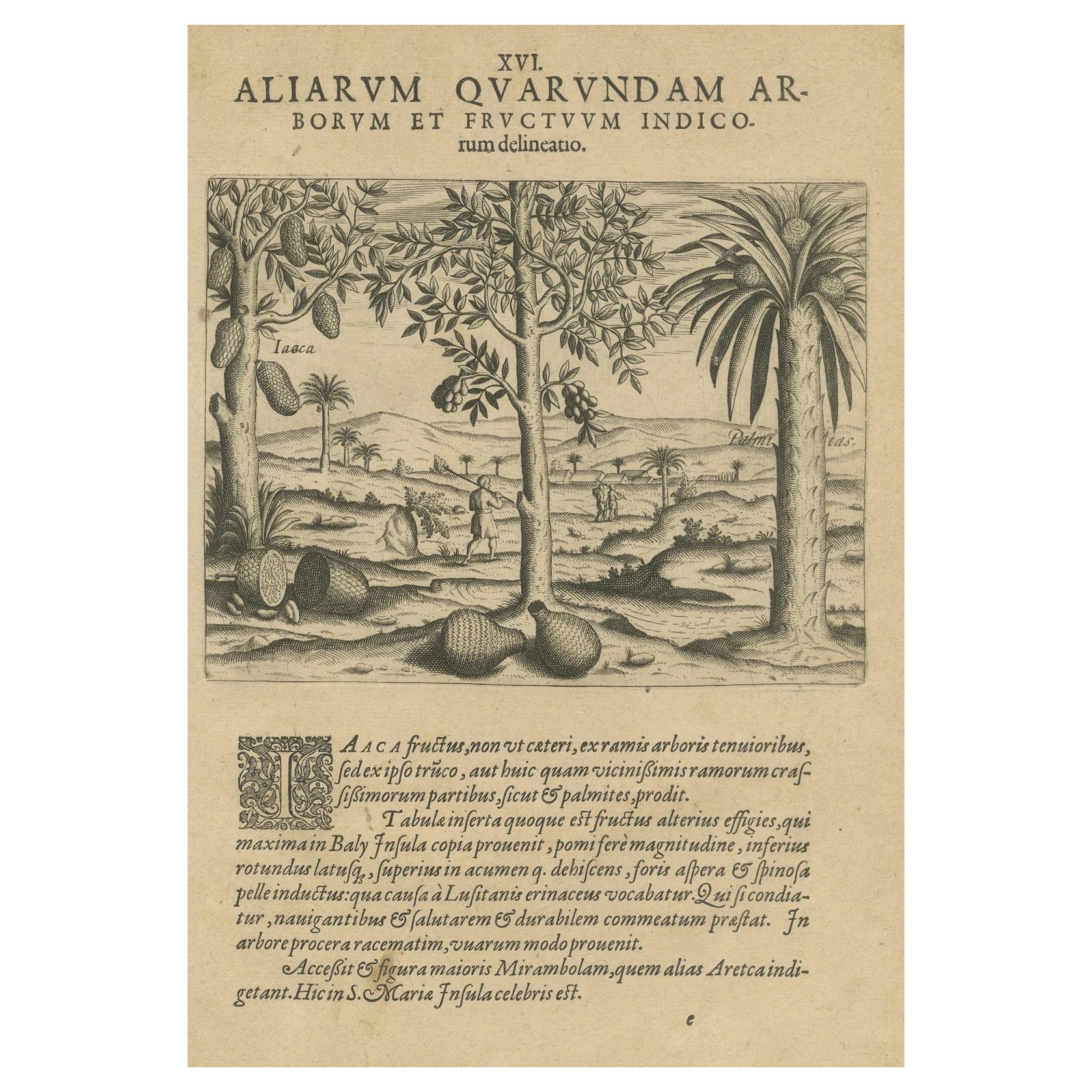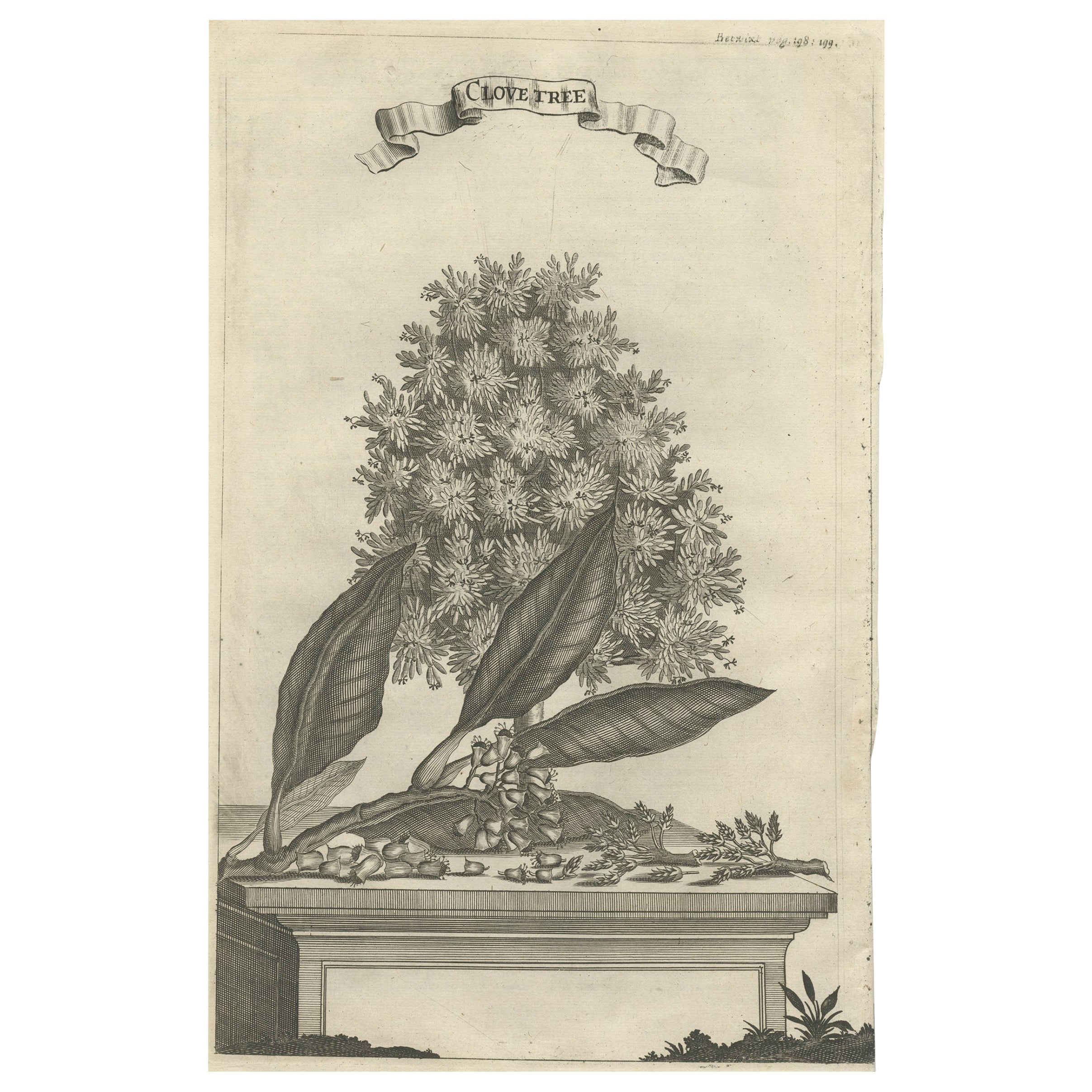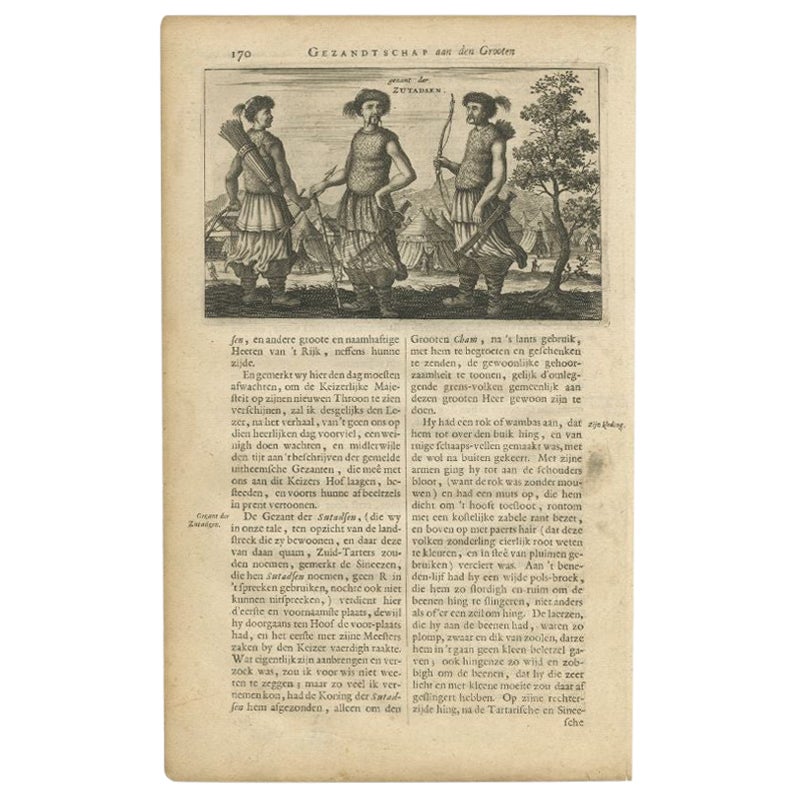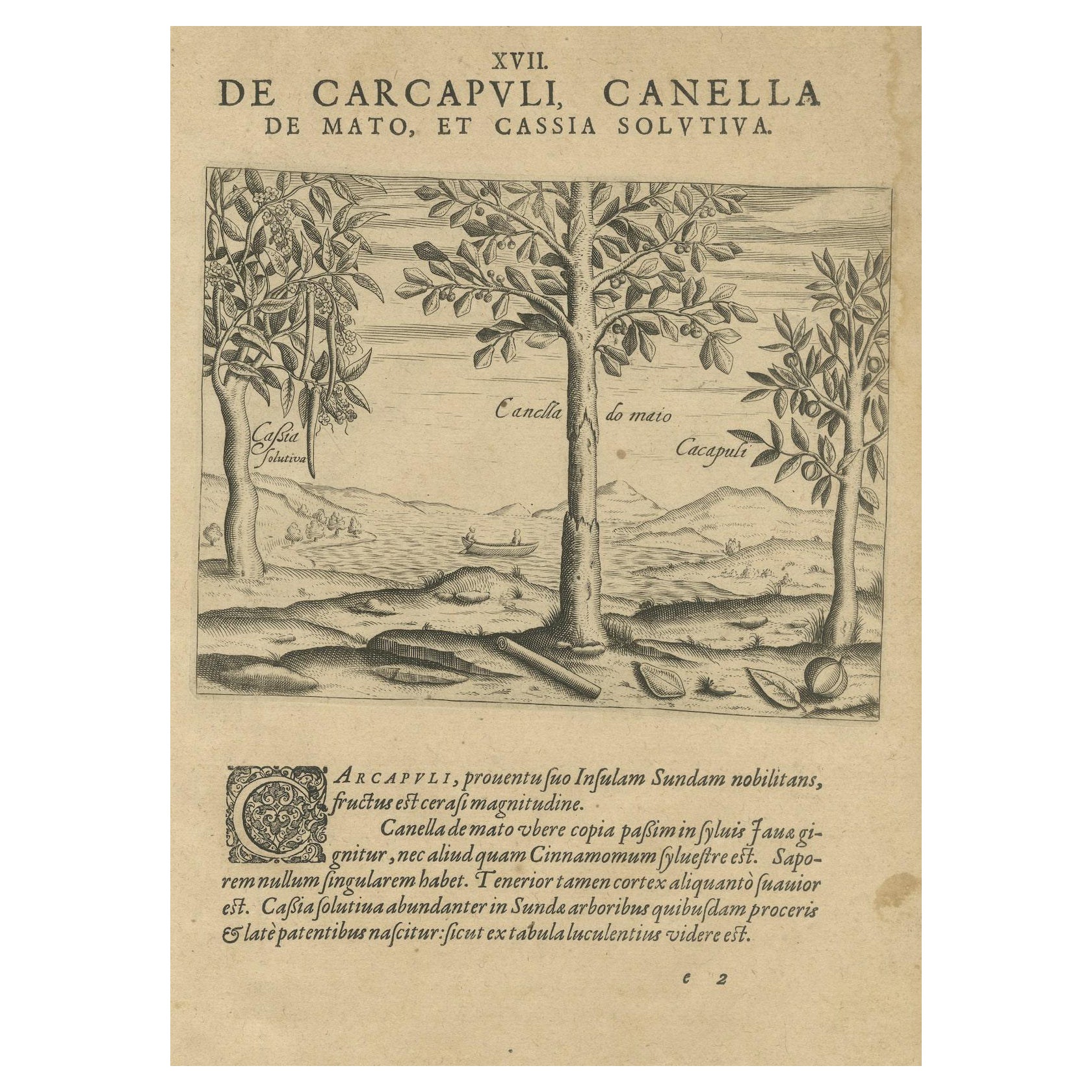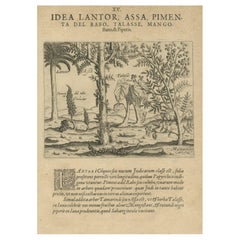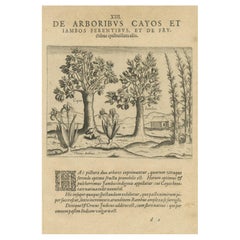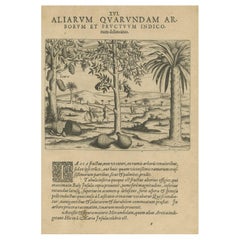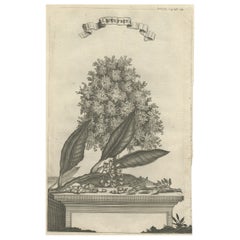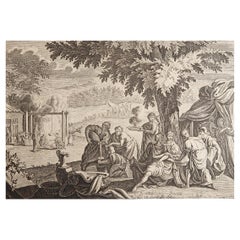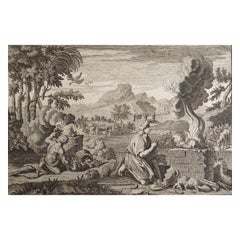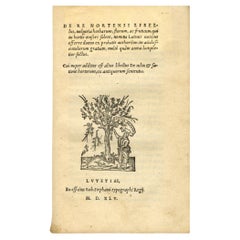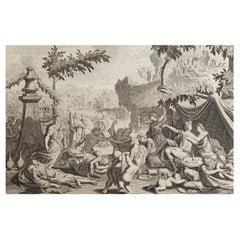Items Similar to The Melancholy Tree of the East: A 1601 de Bry Engraving from 'Indiae Orientalis
Want more images or videos?
Request additional images or videos from the seller
1 of 9
The Melancholy Tree of the East: A 1601 de Bry Engraving from 'Indiae Orientalis
$525.26
$656.5720% Off
£386.97
£483.7220% Off
€440
€55020% Off
CA$722.92
CA$903.6520% Off
A$802.19
A$1,002.7420% Off
CHF 423.14
CHF 528.9220% Off
MX$9,793.04
MX$12,241.3020% Off
NOK 5,353.50
NOK 6,691.8720% Off
SEK 5,013.98
SEK 6,267.4820% Off
DKK 3,349.31
DKK 4,186.6420% Off
About the Item
This engraving from Theodore de Bry's "Indiae Orientalis" showcases a serene yet intriguing scene titled "EFFIGIES ILLIUS ARBORIS, QUAM TRISTEM VOCANT," which translates to "The Image of That Tree They Call Sad." Dated 1601 and featured in the first edition of Part III, Plate VI, the work depicts a tree that was noted for its unusual characteristics and was part of De Bry’s extensive "Petit Voyages" series.
In the image, several figures engage in various activities around the tree and the adjacent building. One person reclines leisurely with a bowl, perhaps enjoying the shade or fruit of the tree, while others appear to be collecting or processing the tree's produce. A couple rides on an ox, adding to the pastoral calm of the setting. The intricate details in the foliage of the tree and the attire of the figures suggest a foreign landscape rich with stories and life, typical of De Bry’s work that aimed to capture and convey the wonders of newly discovered lands to a European audience.
The text in the image appears to be in Latin. Here is the translation to English:
"A certain kind of tree is well-known in India, which by the singular decree of the gods is said to bloom in a miraculous way. It is called Arbor tristis, that is, the 'sad tree,' because it blooms continuously throughout the year, but it does not bloom at night. Indeed, at no time is the flower seen, because as soon as the sun sets, the hemisphere below the earth occupies it. And where it first appears, the whole tree immediately bursts forth with white flowers, which however suddenly fall off as soon as the sun rises, as if they were sorrowful. Thus, not even a little bit of them remains in the tree. And in this way the condition of the place is changed throughout the year."
This plate is part of the "Petit Voyages" or "Small Voyages," a series that complemented the "Grands Voyages" or "Great Voyages." Theodore de Bry, a noted engraver and publisher from Liège, Belgium, began these works to illustrate the New World and the Far East based on accounts and drawings from explorers. His works grew to comprise 30 volumes, with later editions published by his children after his death. This particular engraving is a testament to the enduring allure of the unknown that captivated the minds of Europeans during the Age of Exploration.
This piece forms part of a larger corpus of works produced under the supervision of the de Bry family, a lineage of renowned engravers and publishers based in Frankfurt. Initiated by Theodore de Bry in 1590, this series aimed to visually document the epoch of European global exploration and the encounters with the natural world that ensued.
The engraving is a page from Part IV of de Bry's "Petits Voyages," which narrates significant expeditions to the East Indies, including those led by Jan Juygen van Linschoten and Cornelis de Houtman between 1595-97, as well as the journey by Jacob van Neck and Wybrandt van Warwijck in 1598-99. These works were not merely artistic endeavors but also ethnographic records, showcasing indigenous peoples, fauna, flora, and the diverse riches of lands like India, Madagascar, and the East Indies.
Though Theodore de Bry began this ambitious project, it was continued posthumously by his family and later completed by his son-in-law, Matthaus Merian, in 1644. This particular engraving, rich in detail and drama, offers a window into the perilous and wondrous experiences of early explorers, and the ways in which these moments were captured and communicated to a European audience hungry for knowledge of the wider world.
- Dimensions:Height: 11.82 in (30 cm)Width: 7.88 in (20 cm)Depth: 0 in (0.02 mm)
- Materials and Techniques:Paper,Engraved
- Period:Early 17th Century
- Date of Manufacture:1601
- Condition:The condition of the print is very good, considering its age of over 400 years. Light brownish toning and some soiling due to handling, mainly around the edges. Please study this image carefully.
- Seller Location:Langweer, NL
- Reference Number:Seller: BG-13596-71stDibs: LU3054337755082
About the Seller
5.0
Recognized Seller
These prestigious sellers are industry leaders and represent the highest echelon for item quality and design.
Platinum Seller
Premium sellers with a 4.7+ rating and 24-hour response times
Established in 2009
1stDibs seller since 2017
2,569 sales on 1stDibs
Typical response time: <1 hour
- ShippingRetrieving quote...Shipping from: Langweer, Netherlands
- Return Policy
Authenticity Guarantee
In the unlikely event there’s an issue with an item’s authenticity, contact us within 1 year for a full refund. DetailsMoney-Back Guarantee
If your item is not as described, is damaged in transit, or does not arrive, contact us within 7 days for a full refund. Details24-Hour Cancellation
You have a 24-hour grace period in which to reconsider your purchase, with no questions asked.Vetted Professional Sellers
Our world-class sellers must adhere to strict standards for service and quality, maintaining the integrity of our listings.Price-Match Guarantee
If you find that a seller listed the same item for a lower price elsewhere, we’ll match it.Trusted Global Delivery
Our best-in-class carrier network provides specialized shipping options worldwide, including custom delivery.More From This Seller
View AllVerdant Wonders: Exotic Trees and Spices of India in De Bry's 1601 Illustration
Located in Langweer, NL
Title: "Verdant Wonders: Exotic Trees and Spices of India in De Bry's 1601 Illustration"
Description: This striking 1601 engraving by Theodore de Bry, titled "IDEA LANTOR, ASSA, PIM...
Category
Antique Early 17th Century Prints
Materials
Paper
$525 Sale Price
20% Off
Exotic Flora of the Indies: The Cajus and Jambos Trees Copper Engraved in 1601
Located in Langweer, NL
Title: "Exotic Flora of the Indies: The Cajus and Jambos Trees in De Bry's 1601 Engraving"
Description: This detailed engraving by Theodore de Bry, dating back to 1601, beautifully illustrates two tropical trees, the Cajus and the Jambos, both renowned for their delectable fruits in the regions of India. The Cajus tree, likely referring to what is known today as the cashew, is depicted with its distinctive fruit that dangles below the swollen pedicel, commonly called the cashew apple. The Jambos tree, with its lush, dense foliage and abundant fruiting, could be related to the rose apple, known for its fragrant, rose-scented fruit.
Included in the scene is a depiction of the Indian Crocus, adding a touch of the diverse understory vegetation of the tropical climate. The image conveys a peaceful coexistence with nature, as indicated by a modest dwelling in the background, suggesting the integration of these trees into the daily lives of the local inhabitants for both nourishment and commerce.
The text is in Latin, and here is the English translation:
"In this picture, two trees are shown, each of which bears the most excellent and noble fruit. The best of these is called the Jambos, native to the region, which the inhabitants call Cayos. On this tree, nothing of note is bestowed.
Moreover, this also represents a marvelous spectacle, in which the slow-growing cane bamboo surrounds itself. Finally, the Indian Crocus has been added, which blooms with its native flower; which is widespread throughout all of India."
De Bry's engravings were pivotal in bringing the natural wealth of the New World and the East Indies to the European imagination. His work not only served as an artistic endeavor but also as an educational tool that fed the European appetite for knowledge about the vast diversity of the world's flora and fauna. This engraving, with its precision and attention to botanical detail, remains a significant historical record of the natural world as seen through the lens of the early modern European...
Category
Antique Early 17th Century Prints
Materials
Paper
$525 Sale Price
20% Off
Tropical Abundance: The Jackfruit and Palm Trees in De Bry's 1601 Engraving
Located in Langweer, NL
"Tropical Abundance: The Jackfruit and Palm Trees in De Bry's 1601 Engraving"
Description: This remarkable 1601 engraving by Theodore de Bry illustrates the lush vegetation of India...
Category
Antique Early 17th Century Prints
Materials
Paper
$525 Sale Price
20% Off
Rare Old Copper Engraving of a Clove Tree in the East Indies, Asia, 1659
Located in Langweer, NL
Antique print titled 'Clove Tree'.
Copper engraving of a clove tree. This print originates from 'Voyages and Travels to the East-Indies' by J. Nieuhof.
Artists and engravers:...
Category
Antique 1650s Prints
Materials
Paper
$267 Sale Price
20% Off
Original Antique Print of an Asian Envoy by Nieuhof, '1665'
Located in Langweer, NL
Antique print titled 'Gezant der Zutadsen'. Old print depicting an Asian Envoy. Also visible are Asian warriors with bows, arrows and swords. This print ...
Category
Antique 17th Century Prints
Materials
Paper
$171 Sale Price
20% Off
Spices of the Tropics: Cinnamon and Cassia in De Bry's 1601 Illustration
Located in Langweer, NL
Title: "Spices of the Tropics: Cinnamon and Cassia in De Bry's 1601 Illustration"
Description: This 1601 engraving by Theodore de Bry offers a detailed look at the spice-bearing tre...
Category
Antique Early 17th Century Prints
Materials
Paper
$458 Sale Price
20% Off
You May Also Like
Original Antique Print After Jan Luyken, Amsterdam. Genesis XVIII. 1724
Located in St Annes, Lancashire
Wonderful copper-plate engraving after Jan Luyken
Published by Marten Schagen, Amsterdam. 1724
Text on verso
The measurement given is the paper size.
Category
Antique 1720s Dutch Renaissance Prints
Materials
Paper
Original Antique Print after Jan Luyken, Amsterdam, Genesis IV, 1724
Located in St Annes, Lancashire
Wonderful copper-plate engraving after Jan Luyken
Published by Marten Schagen, Amsterdam. 1724
Text on verso
The measurement given is the paper size.
Category
Antique 1720s Dutch Renaissance Prints
Materials
Paper
De re hortensi libellus, a 16th Century Children's Gardening Book
Located in Middletown, NY
Estienne, Charles
De re hortensi libellus (A small book on gardening); . . . vulgaria herborum, florum ac fruticum qui in hortis conseri solent nomina latinis vocibus efferre docens ...
Category
Antique 16th Century French Books
Materials
Gold Leaf
Original Antique Print after Jan Luyken, Amsterdam, Genesis VI, 1724
Located in St Annes, Lancashire
Wonderful copper-plate engraving after Jan Luyken
Published by Marten Schagen, Amsterdam. 1724
Text on verso
The measurement given is the paper size.
Category
Antique 1720s Dutch Renaissance Prints
Materials
Paper
Original Antique Print after Jan Luyken, Amsterdam, Genesis XIII, 1724
Located in St Annes, Lancashire
Wonderful copper-plate engraving after Jan Luyken
Published by Marten Schagen, Amsterdam. 1724
Text on verso
The measurement given is the paper size.
Category
Antique 1720s Dutch Renaissance Prints
Materials
Paper
Original Antique Print After Jan Luyken, Amsterdam, Genesis IX, 1724
Located in St Annes, Lancashire
Wonderful copper-plate engraving after Jan Luyken
Published by Marten Schagen, Amsterdam. 1724
Text on verso
The measurement given is the paper size.
Category
Antique 1720s Dutch Renaissance Prints
Materials
Paper
More Ways To Browse
Spanish Colonial Plates
Specimen Chest
Steel Guitar
Syria Jewelry
Tall Mid Century Modern Buffet
Tall Narrow Shelves
Tamil Nadu
Terracotta Sink
Thai Bamboo
Thai Dragons
Thai Statue Wood
Tibetan Buddha Statue
Tiffany Glass Mirror
Tin Horse
Tubular Chrome Shelf
Unglazed Clay Jar
Used Metal Storage Bins
Vaseline Uranium Glass
